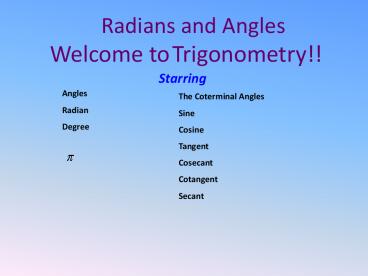Radians and Angles - PowerPoint PPT Presentation
1 / 33
Title:
Radians and Angles
Description:
Radians and Angles Welcome to Trigonometry!! Starring The Coterminal Angles Sine Cosine Tangent Cosecant Cotangent Secant Angles Radian Degree Warm Up Convert to ... – PowerPoint PPT presentation
Number of Views:298
Avg rating:3.0/5.0
Title: Radians and Angles
1
Radians and Angles
Welcome to Trigonometry!!
Starring
The Coterminal Angles Sine Cosine Tangent Cosecan
t Cotangent Secant
2
Degree Measure
Over 2500 years ago, the Babylonians used a
number system based on 60
The number system we use today is based on 10
However we still use the Babylonian idea to
measure certain things such as time and angles.
That is why there are 60 minutes in an hour and
60 seconds in a minute.
3
The Babylonians divided a circle into 360 equally
spaced units which we call degrees.
In the DMS (degree minute second) system of
angular measure, each degree is subdivided into
60 minutes (denoted by ) and each minute is
subdivided into 60 seconds (denoted by )
4
Since there are 60 in 1 degree we can convert
degrees to minutes by multiplying by the
conversion ratio
5
Convert 34.80 to DMS
We need to convert the fractional part to minutes
6
Convert 112.420 to DMS
Convert the fractional part
Convert the fractional part of the minutes into
seconds
7
Convert 4202436 to degrees
This is the reverse of the last example. Instead
if multiplying by 60, we need to divide by 60
8
Radian Measure
The circumference of a circle is 2pr
In a unit circle, r is 1, therefore the
circumference is 2p
A radian is an angle measure given in terms of p.
In trigonometry angles are measured exclusively
in radians!
1
9
Radian Measure
Since the circumference of a circle is 2p
radians, 2p radians is equivalent to 360 degrees
1
10
Radian Measure
Half of a revolution (1800) is equivalent to
radians
1
11
Radian Measure
One fourth of a revolution (900) is equivalent to
radians
1
12
Since there are 2p radians per 3600, we can come
up with the conversion ratio of
radians
degrees
radians
Which reduces to
degrees
13
To convert degrees to radians multiply by
radians
degrees
14
To convert radians to degrees multiply by
degrees
radians
15
To convert 900 to radians we can multiply
radians
2
radians
16
We also know that 900 is ¼ of 2p
radians
17
Arc length formula
If ? (theta) is a central angle in a circle of
radius r, and if ? is measured in radians, then
the length s of the intercepted arc is given by
THIS FORMULA ONLY WORKS WHEN THE ANGLE MEASURE IN
IS RADIANS!!!
r
s
?
18
formed by rotating a ray about its endpoint
(vertex)
Ending position
Starting position
Initial side on positive x-axis and the vertex is
on the origin
Standard Position
19
Angle describes the amount and direction of
rotation
Positive Angle- rotates counter-clockwise
(CCW) Negative Angle- rotates clockwise (CW)
20
Coterminal Angles
- Angles with the same initial side and same
terminal side, but have different rotations, are
called coterminal angles. - 50 and 410 are coterminal angles. Their
measures differ by a multiple of 360.
21
Q Can we ever rotate the initial side
counterclockwise more than one revolution?
Answer YES!
EXIT
BACK
NEXT
22
Note Complete RevolutionsRotating the initial
side counter-clockwise 1 rev., 2 revs., 3revs.,
. . . generates the angles which measure 360?,
720?, 1080?, . . .
EXIT
BACK
NEXT
23
Picture
EXIT
BACK
NEXT
24
ANGLES 360, 720, 1080 ARE ALL COTERMINAL ANGLES!
25
What if we start at 30? and now rotate our
terminal side counter-clockwise 1 rev., 2 revs.,
or 3 revs.
EXIT
BACK
NEXT
26
Coterminal Angles
Two angles with the same initial and terminal
sides
Find a positive coterminal angle to 20º
Find a negative coterminal angle to 20º
27
Warm Up
- Convert to Degrees minutes, seconds
- Convert to Radians
28
What did you find?
These are just two possible answers.
Rememberthere are more! ?
29
Complementary Angles Two angles whose sum is 90?
Supplementary Angles Two angles whose sum is
180?
30
Convert to radians
31
Convert to degrees
32
Express 50.525? in degrees, minutes, seconds
50º .525(60) ?
50º 31.5?
50º 31? .5(60) ?
50 degrees, 31 minutes, 30 seconds
33
CW/HW
- Page 280-281 (1, 3, 5-8, 11-14, 30-33)































